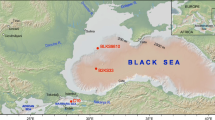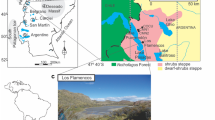Abstract
The concept of an arid pleniglacial in the Middle East depends primarily on the interpretation of pollen diagrams including those of Lake Zeribar in the Zagros Mountains of western Iran. It has been assumed that Lake Zeribar was surrounded by a Chenopodiaceae-Artemisia steppe and that the climate was therefore dry. Both assumptions are questioned. The environment of Pleistocene Lake Zeribar may have been similar to the tragacanthic or alpine zone of the modern Zagros Mountains. The dominance by pollen of Chenopodiaceae and Artemisia is explained by low pollen production of high-altitude vegetation, preferential incorporation of pollen of late-blooming plants into the sediments, and high production and long-distance transport of lowland pollen. In any case, high percentages of Chenopodiaceae and Artemisia pollen do not necessarily indicate low annual precipitation but a highly seasonal climate with cold winters and hot, dry summers. Such a climatic regime was in effect continuous except for a period beginning about 10600 B. P. during which summer rainfall or reduced summer drought occurred. This change in seasonality resulted in the dominance of Poaceae pollen and the initial increase in arboreal pollen. A moisture curve based on the ratio between Chenopodiaceae and Artemisia pollen indicates a pleniglacial climate with wet winters and a late-glacial and early-Holocene climate with periods of intense aridity. The climatic history presented here is compatible with non-palynological evidence of regional late Pleistocene climates and with seasonality changes suggested by climatic modelling based on orbital parameters.
Similar content being viewed by others
Abbreviations
- C/A:
-
Chenopodiaceae-Artemisia ratio
References
Al-Rawi A. 1964. Wild plants of Iraq with their distribution. Tech. Bull. 14, Ministry Agric, Baghdad.
Birks H. J. B. & Birks H. H. 1980. Quaternary palaeoecology. Arnold, London.
Bottema S. 1979. Pollen analytical investigations in Thessaly (Greece). Palaeohistoria 21: 19–40.
Bottema S. & Barkoudah Y. 1979. Modern pollen precipitation in Syria and Lebanon and its relation to vegetation. Pollen Spores 21: 427–480.
Butzer K. 1958. Quaternary stratigraphy and climate in the Near East. Bonner Geogr. Abh. 24: 1–157.
Charlesworth J. 1957. The Quaternary era. Arnold, London.
El-Moslimany, A. 1982. The late Quaternary vegetational history of the Zagros and Taurus Mountains in the regions of Lake Mirabad, Lake Zeribar, and Lake Van-a reappraisal. In: J. Bintliff & W. Van Zeist (eds), Palaeoclimates, palaeoenvironments and human communities in the eastern Mediterranean region in later Prehistory. BAR Int. Ser. 133(ii) pp. 343–351, London.
El-Moslimany, A. 1983. History of climate and vegetation in the eastern Mediterranean and Middle East from the Pleniglacial to the Mid-Holocene. Ph.D. Dissertation. Univ. Washington.
El-Moslimany A. 1984. Comment on ‘Age, palaeoenvironments and climatic significance of late Pleistocene Konya Lake, Turkey’ by Neil Roberts. Quar. Res. 21: 115–116.
El-Moslimany A. 1986. Ecology and late Quaternary history of the Kurdo-Zagrosian oak forest near Lake Zeribar, Kurdistan (western Iran). Vegetatio 68: 55–63.
Evans L. 1964. Reproduction. In: C. Barnard (ed.), Grasses and grassland. pp. 126–153. Macmillan, New York.
Faegri K. & Iversen J. 1975. Textbook of pollen analysis, 3rd ed. Blackwell, London.
Fautin R. W. 1946. Biotic communities of the northern desert shrub biome in western Utah. Ecol. Monogr. 16: 251–310.
Freitag H. 1977. The Pleniglacial, Late-Glacial and early Postglacial vegetations of Zeribar and their present-day counterparts. A supplement to W. Van Zeist & S. Bottema, Palynological investigations in western Iran. Palaeohistoria. 14: 87–95.
Georgiev V. & Stoffers P. 1980. Surface texture of quartz grains from late Pleistocene to Holocene sediments of the Persian Gulf/Gulf of Oman — an application of the scanning electron microscope. Mar. Geol. 36: 85–96.
Guest E. & Al-Rawi A. 1966. Flora of Iraq. Vol. I. Ministry Agric. Baghdah.
Hadač E. & Agnew A. D. Q. 1963. Plant communities of Helgurd Mountain. Iraq. Bull. Iraq Nat. Hist. Inst. 2: 1–16. Univ. Baghdad.
Hutchinson C. & Cowgill U. 1963. Chemical examination of a core from Lake Zeribar, Iran. Science 140: 67–69.
Kutzbach J. & Guetter P. 1986. The influence of changing orbital parameters and surface boundary conditions on climate simulations for the past 18 000 years. J. Atmos. Sci. 43: 1726–1759.
Kutzbach J. & Street-Perrott F. A., 1985. Milankovitch forcing of fluctuations in the level of tropical lakes from 18 to 0 kyr B.P. Nature 317: 130–134.
Latting J. 1972. Differentiation in the grass inflorescence. In: V. B. Youngner & C. M. McKell (eds), The biology and utilization of grasses pp. 365–399. Academic Press, New York.
Maher L. 1963. Pollen analysis of surface materials from the southern San Juan Mountains, Colorado, Geol. Soc. Am. Bull. 74: 485–1503.
Markgraf V. 1980. Pollen dispersal in a mountain area. Grana 19: 127–146.
McClure H. 1978. Ar Rub Al Khali. In: S. Al-Sayari & J. Zotl (eds), Quaternary period in Saudi Arabia. pp. 252–263. Springer-Verlag, New York.
Megard R. 1967. Late Quarternary Cladocera of Lake Zeribar. Ecology 48: 179–189.
Moore P. & Stevenson A. 1982. Pollen studies in dry Environments. In: B. Spooner & H. Mann (eds), Desertification and development, dryland ecology in social perspective. pp. 249–267, Academic Press, New York.
Jiklewski J. & Van Zeist W. 1970. a late Quarternary pollen diagram from northwest Syria. Acta Bot. Neerl. 19: 737–754.
Roberts, N. 1982. Lake levels as an indicator of Near Eastern Palaeoclimates: A preliminary appraisal. In: J. Bintliff & W. Van Zeist (eds), Palaeoclimates, palaeoenvirnments and human communities in the Eastern Mediaterranean region in later Prehistory. BAR International Series 133(ii) pp. 343–351, London.
Roberts N. 1983. Age, palaeoenvironments and climatic significance of Late Pleistocene Konya Lake, Turkey. Quat. Res. 19: 154–171.
Sarntheim M. 1972. Sediments and history of the postglacial transgression of the Persian Gulf and northwest Gulf of Oman. Mar. Geol. 12: 245–266.
Stoffers P. & Ross D. 1978. Late Pleistocene and Holocene sedimentation in the Persian Gulf-Gulf of Oman. Sed. Geol. 23: 181–208.
Street F. & Grove A. 1979. Global maps of lake-level fluctuations since 30,000 years B.P. Quat. Res. 12: 83–118.
Street-Perrott A. & Harrison S. 1985. Lake-level fluctuations. In: A. Hecht (ed.), Paleoclimate analysis and modeling. pp. 291–340. Wiley, New York.
Street-Perrott A. & Roberts N. 1983. Fluctuations in closed lakes as an indicator of past atmospheric circulation patterns. In: F. A. Street-Perrot, M. A. Beran & R. Ratcliffe (eds), Variations in the global water budget. pp. 331–345, Reidel, Dordrecht.
Thalen D. 1979. Ecology and utilization of desert shurb rangelands in Iraq. Junk, The Hague.
Van Zeist W. 1967. Late Quarternary vegetation history of western Iran. Rev. Paleobot. Palynol. 2: 301–311.
Van Zeist W. & Bottema S. 1977. Palynological investigations in western Iran. Palaeohistoria 19: 19–85.
Van Zeist W. & Woldring H. 1978. A postglacial pollen diagram from Lake Van in East Anatolia. Rev. Paleobot. Palynol. 26: 249–276.
Van Zeist, Woldring H. & Stapert D. 1975. Late Quarternary vegetation and climate of southwestern Turkey. Palaeohistoria 17: 55–143.
Van Zeist W. & Wright H. E. 1963. Preliminary pollen studies at Lake Zeribar, Zagros Mountains, southwestern Iran. Science 140: 65–67.
Van Zeist, W. & Bottema, S. 1982. Vegetational history of the eastern Mediterranean and the Near East during the last 20 000 years. In: J. Bintcliff & W. Van Zeist (eds), Palaeoclimates, palaeoenvironments and human communities in the Eastern Mediterranean region in later prehistory. pp. 277–323. BAR International Series 133(ii), London.
Walter H. 1971. Ecology of tropical and subtropical vegetation. Translated by D. Mueller-Dombois. Oliver and Boyd, Edinburgh.
Wasylikowa K. 1967. Late Quaternary plant macrofossils from Lake Zeribar, western Iran. Rev. Paleobot. Palynol. 2: 313–318.
Wijmstra T. 1969. Palynology of the first 30 meters of a 120 m deep section in northern Greece. Acta Bot. Neerl. 18: 511–527.
Willis J. 1973. A dictionary of the flowering plants and ferns. 8th ed. Cambridge University Press, Cambridge.
Wright H. E. 1962. Pleistocene glaciation in Kurdistan. Eiszeitalter Gegenw. 12: 131–164.
Wright H. E., McAndrews J. & Van Zeist W. 1967. Modern pollen rain in western Iran and its relation to plant geography and Quaternary vegetation history. J. Ecol. 55: 415–443.
Zeuner F. 1959. The Pleistocene period, its climate, chronology and faunal successions. Hutchinson, London.
Zohary M. 1973. Geobotanical foundations of the Middle East. Vol. I and II Gustav Fischer Verlag, Stuttgart.
Author information
Authors and Affiliations
Rights and permissions
About this article
Cite this article
El-Moslimany, A.P. The late Pleistocene climates of the Lake Zeribar region (Kurdistan, western Iran) deduced from the ecology and pollen production of nonarboreal vegetation. Vegetatio 72, 131–139 (1987). https://doi.org/10.1007/BF00039834
Accepted:
Issue Date:
DOI: https://doi.org/10.1007/BF00039834




